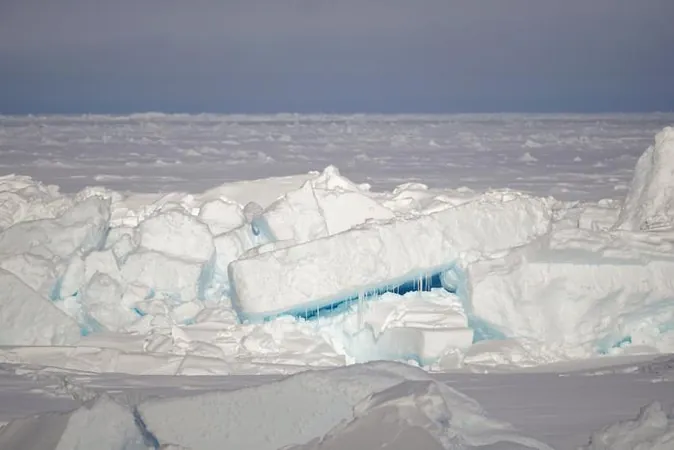
Alarming Decline of Arctic Pressure Ridges: What It Means for the Future of the Polar Ecosystem
2025-01-08
Author: Sarah
The Vital Role of Arctic Pressure Ridges
Arctic pressure ridges serve not only as physical barriers for shipping but also play a significant role in the ecosystem. These ridges are created through lateral pressures from wind and ocean currents, resulting in structures that reach impressive heights and depths. The "sail" of a pressure ridge typically rises one to two meters above the water, while its "keel" can extend downwards to depths of 30 meters, making them formidable obstacles for maritime navigation.
These features are not merely geological; they also significantly impact the Arctic's energy and mass balance, as well as its biogeochemical cycling. They contribute to turbulent mixing of waters, which in turn increases nutrient availability for various marine organisms. Additionally, pressure ridges provide shelter for ice-associated species, including polar bears, which rely on them as safe havens for birthing and overwintering.
A Startling Decline Observed
The AWI team processed extensive laser-based data amassed over 30 years of research flights, covering approximately 76,000 kilometers. Their findings indicate a reduction in both the frequency and height of pressure ridges north of Greenland and in Fram Strait by 12.2% and 5% per decade, respectively. In the Lincoln Sea, an area known for its accumulation of old ice, the stats are even grimmer: a 14.9% decline in frequency and a 10.4% drop in height per decade.
According to Dr. Thomas Krumpen, a sea-ice expert and lead author of the study, this alarming trend highlights a shift as the Arctic is now predominantly composed of younger, thinner ice — which breaks down more easily and forms pressure ridges more readily, yet still fails to mitigate their overall decline.
Implications for the Arctic Ecosystem
The repercussions of these changes extend far beyond just the physical landscape. To understand the overarching effects on the Arctic ecosystem, researchers have combined observational data and satellite imagery for a comprehensive analysis. Yet more work is needed. Current models must evolve to incorporate both the physical characteristics and biological processes associated with various age groups of sea ice.
There’s a pressing need to understand the significance of pressure ridge age—evidence points towards an increase in ridges that do not survive their first summer, suggesting a troubling trend that could affect a myriad of Arctic species.
Dr. Luisa von Albedyll, another contributor to the study, noted that while one might expect slower drift as the sails shrink, concurrent factors like intensified ocean currents or a smoother underside of the ice due to excessive melting could be counteracting this effect.
Future Research Directions
Looking ahead, a significant expedition aboard the research vessel Polarstern is scheduled for next summer, aiming to investigate the biological and biogeochemical distinctions between different age groups of pressure ridges. Accompanying this will be detailed aerial survey flights that aim to deepen our understanding of the intricate relationships between sea ice, climate, and ecosystem dynamics.
As the Arctic undergoes profound changes, it is more crucial than ever for researchers to amass data that can help predict future trends and protect this fragile environment. The implications for global climate change are dire, and the stakes for those who depend on the Arctic for their survival—both human and wildlife—have never been higher.
 Brasil (PT)
Brasil (PT)
 Canada (EN)
Canada (EN)
 Chile (ES)
Chile (ES)
 Česko (CS)
Česko (CS)
 대한민국 (KO)
대한민국 (KO)
 España (ES)
España (ES)
 France (FR)
France (FR)
 Hong Kong (EN)
Hong Kong (EN)
 Italia (IT)
Italia (IT)
 日本 (JA)
日本 (JA)
 Magyarország (HU)
Magyarország (HU)
 Norge (NO)
Norge (NO)
 Polska (PL)
Polska (PL)
 Schweiz (DE)
Schweiz (DE)
 Singapore (EN)
Singapore (EN)
 Sverige (SV)
Sverige (SV)
 Suomi (FI)
Suomi (FI)
 Türkiye (TR)
Türkiye (TR)
 الإمارات العربية المتحدة (AR)
الإمارات العربية المتحدة (AR)